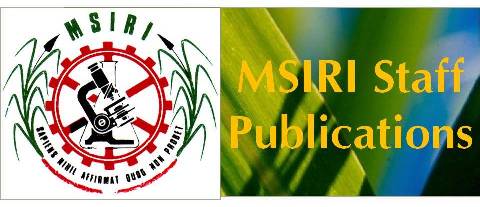Evaluation and selection of different types of sugarcane varieties for multi-purpose use from a population of inter-specific derived clones in Mauritius
| MSI10P4483 | |
| Santchurn, D. | |
| Department of Plant Sciences, Faculty of Natural and Agricultural ciences, University of Free State, South Africa | |
| Evaluation and selection of different types of sugarcane varieties for multi-purpose use from a population of inter-specific derived clones in Mauritius | |
| Thesis, MSc | |
| Thesis | |
| 2010 | |
| En | |
| EN | |
| Sugarcane is among the most efficient producers of biomass per unit area. Populations derived from crosses between sugarcane and related wild species provide a wide source of variation from which various types of canes with high biomass can be identified. To this end, the objective of this study was to characterise and identify high biomass genotypes for multiple uses from the local inter-specific derived germplasm collection. Sixty genotypes of different generations (wild, F1, BC1, BC2) were screened visually and on sucrose and fibre content from the population. They were evaluated in replicated trials with four commercial varieties used as controls. Traits of economic importance, particularly, sugar, fibre and different aboveground biomass yields were measured. Data on cane quality characters were taken at two sampling dates and characters were measured on both fresh and dry weights. The trials were followed up to the first ratoon crop. The source data were validated and few genuine outliers observed were appropriately corrected. A total of 29 parametric traits were analysed individually in each crop cycle. Results showed good reliability of the trials with coefficient of variations within the acceptable limits and good repeatability (H2) values for the majority of the traits. There was a good variation among genotypes allowing selection to operate effectively. Although precisions achievable were higher with dry weight measurements than their corresponding fresh weights, negligible differences were observed with selection simulations. It appeared that in the population of inter-specific derived clones, selection based on cane quality data collected at the pre-harvest season (April) was less efficient than those taken at early-harvest (July). Multivariate data analyses efficiently summarised the data and identified groups of similar genotypes. Principal component analysis was very helpful in visualising the existing variations in the population. Six main clusters were obtained, of which three were of economic interest. Based on inherent variations in cane quality and biomass traits, four types of canes were defined for multiple uses. From Type 1 to Type 4 canes there was a continuous progress in fibre percent. The trait was negatively correlated to sucrose content and the high fibre canes were generally thinner and taller than the commercial controls. A selection algorithm was developed that identified 11 high potential genotypes simultaneously. Biomass yields of three genotypes exceeded those of the commercial controls by >40 per cent. Fibre percent of one Type 4 cane reached 23 per cent while that of the commercial varieties fluctuated at 13 per cent. The results confirmed that high biomass varieties, with variable sucrose and fibre contents, could be obtained from the inter-specific populations. The different types of canes identified provided additional opportunities to exploit the total aboveground biomass of the crop for different end-uses, particularly for bioenergy production. The selection algorithm developed will be extended to the whole selection programme for classifying new sugarcane varieties | |
| Sugarcane breeding selection varieties high biomass genotypes characterisation sucrose content fibre content fibre biomass inter-specific breeding | |
| Mauritius | |
| Cane breeding and genetic improvement | |
| Selection: Policies and methods | |
| 2010-06-15 | |
| En | |
| PB |
